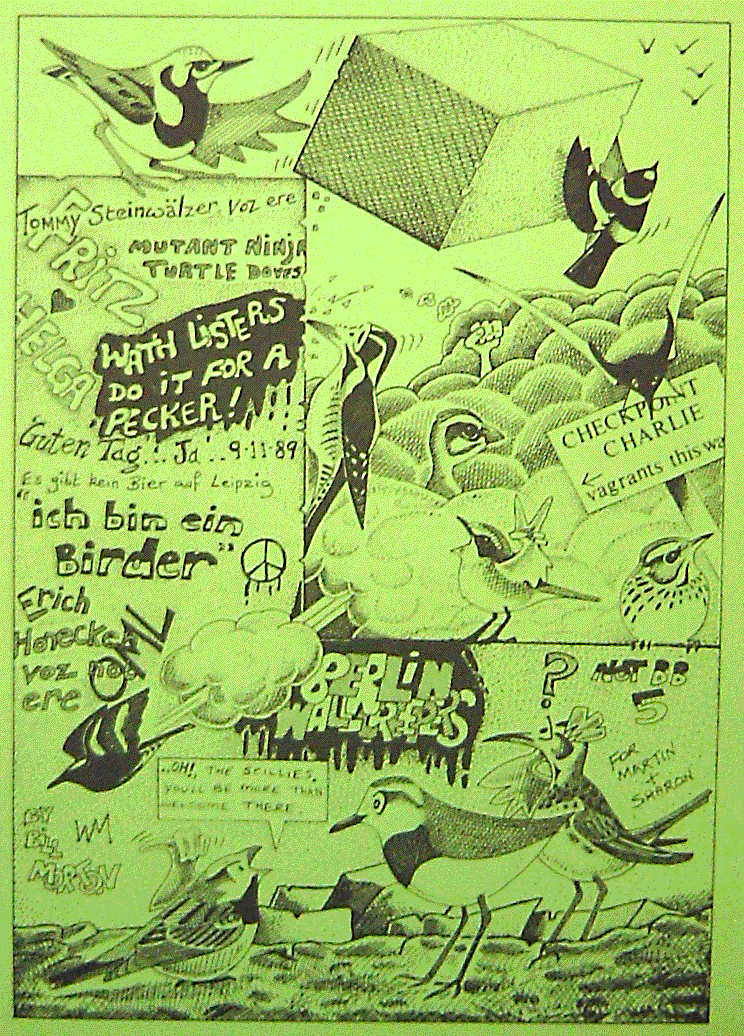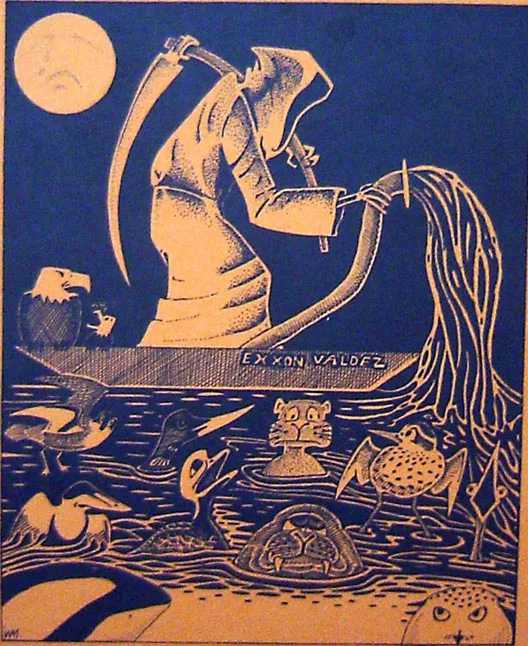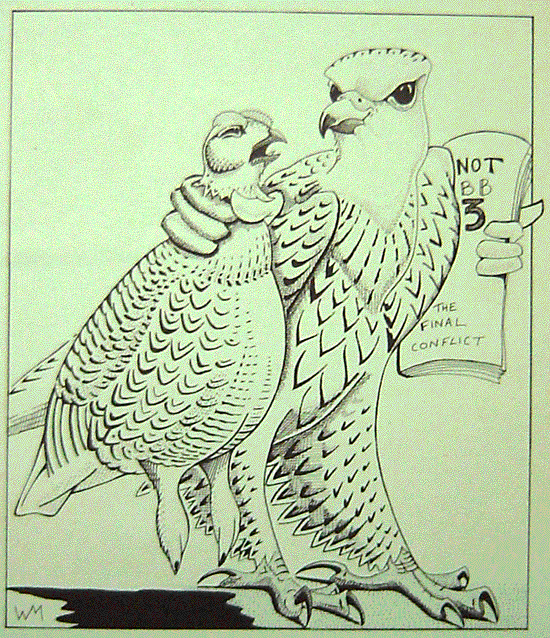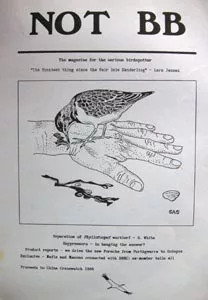The magazine for the serious birdspotter, Vol II
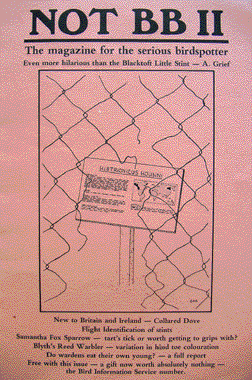
I’d upped and left for the Far East by the time the first NOT BB appeared; heard of its success – read out at log time on Scilly, Prof Shamrock reading it till he cried with laughter. Some people even bought copies, with my share of the loot helping me pay off monies borrowed to chase around after Siberian migrants in the name of science.
Well, we thought, perhaps we should try a second NOT BB. I sent material, Simon n Dan dreamed up more daftness, and there were other contributors too – with a Bill Morton cartoon making an entrance, and an unhealthy obsession with Samantha Fox Sparrows (or was that all me). Vol II was even properly printed, and word-processed on something way better than the initial Amstrad (RIP). albeit without fancy stuff like Italics.
The magazine for the serious birdspotter
“Even more hilarious than the Blacktoft Little Stint” – A. Grief

New to Britain and Ireland – Collared Dove
Flight Identification of Stints
Samantha Fox Sparrow – tart’s tick or worth getting to grips with?
Blyth’s Reed Warbler – variation in hind toe colouration
Do wardens eat their own young? – a full report
Free with this issue – a gift now worth absolutely nothing –
the Bird Information Service number
Editorial
Regular readers will have noticed that Not BB has adopted a new, smaller format in an effort to save on printing and paper costs. To help overcome financial problems, Not BB enterprises have purchased 10,000 acres of boggy wasteland in Sutherland with the intention of planting Sitka Spruce Tringa nebulariser. As a consequence, we will become self sufficient in paper pulp within ten years, will enhance the potential of a potentially barren area with a tree planting scheme and – more importantly – make a real killing from government grants and tax concessions. We trust that readers will appreciate this ecologically sound solution to maintaining subscriptions at their present level.
The editorial office has just received a copy of a rather underhand publication purporting to be a journal for enthusiastic spotters, or is it just a hilarious spoof? Calling itself British Birds, it has as much relevance to the national avifauna as the Bangkok Bird Fanciers’ Gazette. It is so blatantly modelled on our august publication that we are left speechless at one JCV “the Shark” Shamrock. Doubtless, our readers will feel as appalled, outraged and “ever-so’piqued” as us over such blatant plagiarism. We assume that they will have the good taste to steer well clear of this opportunistic, one-off production.
Special rip-off subscription scheme. Members of the following bona-fide organisations are eligibile for reduced subscription rates. If you’re an ornithological library, you pay DOUBLE.
American Birding Association, Inc
Amershan and District Orn. Soc.
Army Birdwatching Society
Bahrain Bustard Hunters
Barnsley Racing Pigeon Club
Chelsea Head Hunters
Cley Clay Pigeon Shooting Society
Cornish Bird Spotting and Stately Home Soc.
JCR Baldock Family
Pennington Parrot Protection League
PJ Grunt Health Club
Spurn Owl Appreciation Group
Tufty Road Safety Club
All holders of the RSVP charge card.
Everybody else.
[header=Identification pitfalls, adverts]
Identification Pitfalls: No. 29 – The Small Brown Job
Each year, the Not BB Rarities Committee receives records for such species as Dusky Warbler, Radde’s Warbler, Red-throated Pipit and Pallas’s Reed Bunting. In all cases the Committee feels that these records can be put down to that very common and all-too-easily ignored bird, the Small Brown Job. The Small Brown Job is a remarkably skulking bird, most often seen briefly during spells of easterly winds in October. Its calls range from a harsh “tac” to a high “tic”. Squeaky “pit-pit-pit” calls and even a resonant booming (Eh?- Eds.) have also been reported. Habitat preferences have variously been…
Read the final gripping instalment of this feature in next month’s issue. We can’t be bothered with it now – Eds.
Advertisements
Dial-A-Dip, the new phone service from Not BB
Are you tired of the rambling directions given by Roy Rogers or the, “I’ve seen em all before, stifles yawn, tries to sound interested,” delivery of Adrian?
Why not enrol with us? Ring vivacious pouting Torquilla for a chatty message giving details of all the birds seen last week and the week before and the year before that. Plus a selection of readings from BWP volumes 1 to 4.
(This message lasts for 400 minutes and costs 25p a second, but it’s still cheaper than BIS)
The NNT Gold Card
Hello, do you know me? Err, well you should, ‘coz I write those crass articles for that new bird magazine.
Anyway, my name is Peter. Even when I’m not recognised, with my new NNT Gold Card I am welcome at hundreds of nature reserves throughout Norfolk, unlike with certain conservation cards I could mention, like Access or Barclaycard.
So, why not become a Gold Card carrying member of the NNT for only £35? You never know, you might even receive a warm welcome at Holme.
Escort Service
Do you feel a bit nerdy when you’re out twitching? You know the sort of thing – parka, scraggy hair, National Health specs and pimples, and just generally look as if you should never go outdoors.
Come on, own up – you’ve wondered how to boost your image, but somehow never quite managed it.
Well for just a few quid, Dial-A-Dip’s new escort service will come to your help.
Choose a buxom lovely from our wide range of News of the Smews page three girls and take her out for the day. Then watch as other birders gasp in amazement as you bowl up and take your place in the throng, with a gorgeous piece of stuff by your side. See their mouths drop as she strokes your inner thigh whilst you coolly scope the gripper. Your cred will rise in minutes, or your money back.
For discreet service, dial the Escortline and ask for Ethel.
What a sexist ad. What was that number again? Eds.
Exclusive Art Kit Offer
Why not create your very own Peter Scott wildfowl masterpiece? Now you can, with this superb art kit from Not BB Enterprises. When completed, you can hang it over the fireplace instead of that David Shepherd elephant print you got from Boot’s.
It’s so easy! Using a soft pencil, simply rub the transfer of a “V” of obscure blobs onto the evening water scape provided.
Then, choose a title from this evocative selection: Pintail over the Dee, Garganey at Eilat, Dawn at Caerlaverock, Slimbridge Sunset, Steamer Ducks over Port Stanley.
Indistinguishable from the real thing and £3000 cheaper! Full refund if your Aunt Nelly can tell the difference.
[header=Secret Diary, familiar bird]
The Secret Diary of Adrian Moleington, continued
Measured my thing last night. Still only 434 3/4. It hasn’t grown for ages! I hope it will grow again this autumn, and catch up with John Rons, who’s got the longest thing in class. Everyone says his is so long that he has to work really hard to make it grow at all, and sometimes when it does it’s all in his mind.
Saw Ethel again today. She served me a specially big piece of bread pudding and then said she couldn’t see me any more. She was worried that I’d take liberties, after going to see that Samantha Fox Sparrow. Libeties, me? I nearly told here that I’m such a man of the World that my thing hardly grows at all. Instead, I gazed deep into the limpet pools that are her eyes, and offered to take her out to look for Nightjars on Saturday. She said she’d like to come, but Roy was going to show her his new answer-phone and, in case I asked, she was washing her hair on Sunday.
Mum and dad were fighting again at breakfast. Mum said everybody goes birdwatching these days. Look at that nice Tony Super and David Batterburger; so dad wasn’t to go around saying his son was one of those Nancy’s boys. Dad just sulked and hid behind his paper – the News of the Smews as usual.
A New Look at Familiar Birds – the Blue Tit
Mrs Larkspur continues our regular series, which was originally printed in the Sunday Telegraph.
This cheeky chappy is no stranger to Britain’s birdlovers. No matter where you live, this colourful, perky bird will brighten up your garden and country jaunts.
Blue Tits are easily attracted to food put out for them. Coconuts, fat, Madeira cake and peanuts can all be successfully used. However, what Blue Tits like best is undoubtedly the top of the milk, which they reach before you do. A small price to pay for having this engaging bird around the garden.
A great deal of fun and satisfaction can be had by building a nesting box, and putting it in a suitable location in your garden. You will be entranced as your Blue Tits pull your favourite pullover to bits as it hangs on the washing line, only to carry this material to their nest in next door’s sandstone wall. However, have no fear – they will return to your garden to feed their delightful brood of 36 young just outside your bedroom window at five in the morning.
What an obnoxious species! I much prefer Starlings.
(The editors would like to point out that although Blue Tits are a fully protected species, a Great Spotted Woodpecker hired from your local pest control expert should nip this problem in the bud.)
Old Dim’s Almanac: extract no. 13
… and in ye autumne there shalt be a great winde from the east which shall bring forth many Siberian waifs and strays…
[header=Shorebirds and raptor ID, Hudwit, Mystery Bird]
Shorebird Identification of European Raptors
Gail Porter and Sarah Ferguson-Lees
It has long been known (Claptrap and Gibberish 1853) that shorebirds (waders they mean, Eds.) show fear of raptors such as Peregrines and Goshawks, whilst they are unperturbed by other shorebirds, ducks and Long-tailed Tits.
Whilst sitting at Frodsham the other day, waiting for the big one to show, musing on the meaning of life and generally wondering how to get some money out of the Research Council, GP wondered to what extent different species of shorebirds are able to discriminate between raptors and non-raptors and, indeed, whether any species show a particular aptitude for raptor identification.
Such an aptitude would seem more likely to be exhibited by old individuals of well travelled species, rather than by young birds of more sedate species (just link among birders – clever eh? Eds.). So Project “Wary Wader” was born.
Methods Six species of shorebirds were tested. These included the Turnstone, since it is easy to feed. Initially, we had hoped to use live raptors for the experiments, but received insufficient grant to cover the nest raiding and transportation costs. Egg collectors were approached, but Red Kite eggs did not appear to cause any alarm; the Turnstones ate them.
We considered using stuffed specimens – but these lack the jizz which is so important in raptor identification. So we decided to show videos to the birds: clips of programmes like Life on Earth, Animal Magic, The Muppet Show, and the full version of Kes, to see at which stage the Kestrel was regarded as a potential threat.
Results The results were interesting. Very interesting. (But stupid? – Eds.)
Follow-up As a follow-up to the work, all the birds were shown footage of recent party political broadcasts. As anticipated, all six shorebirds died: even Turnstones can take only so much crap.
The Hudwit – A Correction
Many pedantic readers have drawn our attention to an unfortunate error in volume 79, no. 9. The graph showing occurrences of the Hudwit Hudwiticus returnicusyetagainus should of course have been as printed below. We apologise to subscribers for this unfortunate and misleading mistake, this ornithological clanger, this avian atrocity, err, this printing error. We humbly present: Figure 1.

Figure 1. Occurrences of the Hudwit in Britain.
Mystery Bird Plate
Last month’s mystery picture was so dreadful that our printers have refused to reproduce it in this issue. It is without doubt the most difficult problem we have set in this feature so far.
Even with the doubtful advantage of the original colour reproduction, identification would not have been any easier. The swirling blue background and the fact that the bird is accompanied by a wobbly, upside-down version of itself suggest an aquatic species. The grey colour of the manle runs down onto the breast and out onto the background, indicating that this bird is in heavy moult. Beyond that, it is difficult to say any more.
However, Dave Wholemeal has suggested the possibility of a gull, Larus sp.
This picture was in fact taken from Bad Watercolour Plates, Volume II. Identification is only clinched when the caption below the plate is read. The bird is in fact a drake Barrow’s Goldeneye Clanger depicta. In the light of the standard of the current offering, this feature has been discontinued.
[header=Twitching (RSVP ad), Royaritans, East Bankers]
RSVP Advertisement
TWITCHING, I CAN HANDLE IT
OK, so I do birding most weekends. I can handle it.
OK, so I miss a few days at work. I can take it.
OK, so I’ve written off two company cars this year. I can cope.
OK, so the mortgage payments are bit behind. No problems there.
OK, so the wife has taken the kids to her mothers. It happens.
OK, so I’ll be unemployed next week.

If you need help, call the Royaritans
The Royaritans
Close to despair? Missed all the big ones this autumn? Been gripped off by your mates? After years of flogging your local patch, some upstart’s come along and turned up a blocker?
For a sympathetic ear, advice from someone who knows about the tough times and who cares, cares deeply, call the Royaritans on this number – 740767 (0263 if you’re outside Cley). If you can’t get through at first, please keep on trying.
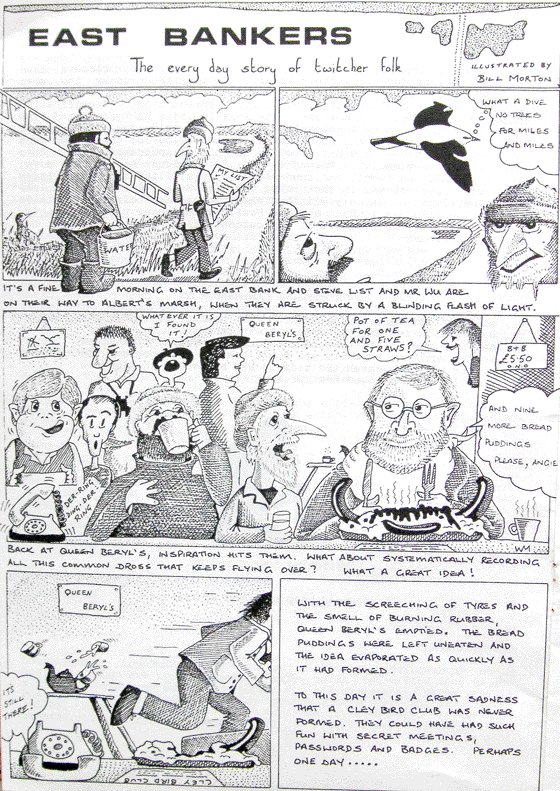
[header=Competition, Birdspeak]
Advertisement
Tally-Ho Chaps! – It’s the Downpour Greasy Coats Competition Entry Form
So, how well do you know the country?
750 pairs of green wellies and 2,000 waxed cotton “Countrylaird” cravats must be won!
To enter, ALL you have to do is to answer the following simple questions about the British countryside and country pursuits, and one of these great prizes could be yours!
1. The skins of which type of bird were used by Victorian ladies as handmuffs?
) the seagull, b) the greater crested grebe, or c) the Greenland y-front.
2. The “Hat and Feathers” is the only surviving wattle and daub public house in the home counties. What is the cost for a pint of Bloodknock’s Best Bitter?
a) £1.80, b) £2.10, or c) 17 guineas
3. The Golden Eagle is Britain’s largest hawk. In Scotland it feeds most commonly on:
a) wolves, b) Highland cattle, or c) shepherds?
4. Which dry white wine is most popularly drunk with golden plover?
……
5. Which of the following did not make it to Lavinia’s most recent hunt ball?
a) Henry and Sarah, b) Sir Algernon and Lady Nosebag, c) Wing-Commander Harvey Leatherflail and Lady Blythe-Pipit
6. Which shooting estate holds the record for the most beaters shot in a day?
a) Lord Mongagu Buckshot’s 1984 Garden Party, b) the Isle of Takthihiroad Grouse Moor, or c) Sandringham.
7. How many dead moles can safely be supported from a 10-yard length of barbed wire fence?
a) 39, b) 55, or c) a waistcoat’s worth.
8. In the fox hunting ritual of blooding, is the swastika painted on:
a) the right cheek, b) the left cheek, c) both buttocks?
9. How far can a red deer stag run when its throat has been ripped out by hounds?
a) 1/4 mile, b) 1/2 mile, or c) not as far as the hounds can.
10. How many miles of waxed cotton thread stitching go into a “Ferreter” handkerchief?
a) who cares? b) I’d better ask my manservant, c) I thought they used glue nowadays.
Complete the following sentence using an IQ of not more than 50:
I like the sound of breaking bones, ripping flesh and the taste of warm blood as it drips down my face, and generally find all blood sports a jolly good turn on because ……………………
(Note to the verbally challenged – the following words and phrases may come in useful: “leafly lanes, the smell of hawthorn blossom, sadist, buttercups, sick, new mown hay, intestines, pervert, locked up, country air, psychiatric problems, upper-class twit” That’s enough hints. Eds.)
Birding Terms Explained
Serendipity – the end of a long series of unsuccessful visits to a North Norfolk field study centre.
It Pays to Increase Your Birdspeak
Bempton – long-time member of local bird club committee. Life list yet to exceed 150.
Blakeney – one who keeps sending in records for birds he didn’t find to the Not BB Rarities Committee, just in case he gets his name in the rarities report.
Blakeney Point – a Blakeney showing off entries in the rarities report.
Cley – sob on missing a major rarity.
Covehithe – birder who’s worked a patch for years, keeps records quiet, but smiles knowingly when various species are mentioned.
Dawlish – the state you’re in when your record has been Peleed (q.v.) in front of a group of birders.
Dunge – the state of the feet after three days sleeping rough in a car on a summer birding trip.
Fleet – tick a bird on minimal view possible.
Fritham – see lots of birds by rushing around and Fleeting (q.v.) them all.
Gib – the feeling of nervous panic experienced when you’ve walked around the north end of St Mary’s for three hours withough seeing another birder.
Hengistbury Head – mystery ailment requiring a day off work, which strikes whenever a major rarity turns up. Most common in early June and November.
Insh – move stealthily towards a bird.
Pelee – to disparagingly put down a record (eg, “Those pale fringes are on the median coverts not the lessers.”).
Skomer – bird which flies through so quickly, it has to be Fleeted by those who need it.
Staines – a state of complete boredom approaching brain-death.
Walney – twit who makes remarks like, “Yeah, yeah, got it, tertial fringes really showing well”.
Welney – a Walney wearing wellies.
Wirral – run around in search of rarities but fail to find any.
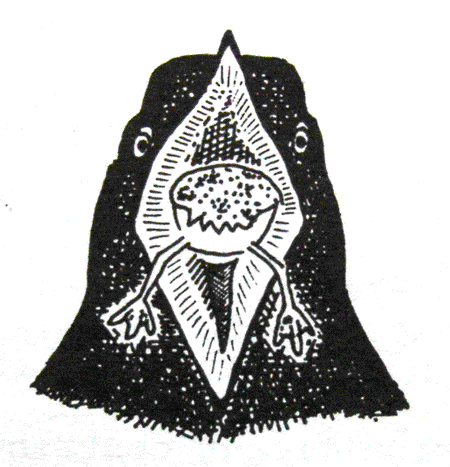
“Avocets always give me a sore throat”
Oriental Bores Club
….and then the first Oriental White Storks started to come through as the pressure started to rise and in the end we recorded 2,729 that’s over twice the known world population you know, you did, oh, then the crane passage started just like Hemmingsen said in his paper and we saw six species with 192 Sibes they’re magic and 497 Japs that’s equal to the Chinese wintering population, Beidaihe is just the end, did I mention the 500 Great Bustards, the Relict Gulls, the Rubythroats, the Needle-tails, the awfuld food, the shield bugs and did I tell you about the time I was crapped on by an Upland Buzzard…. Are you listening?
Not BB Cut-out and Keep Guide to Conservation Organisations
With so many do-gooder conservation organisations about these days, it is difficult to know who does what and whether it is worth buing shares in them. Just what do you get for your money? To remedy this lack of information, we have compiled the following comprehensive summary:
British Trust for Old and Decrepit Birders Best known for their distribution maps of old people’s homes, they are currently planning to build a major orthopaedic day centre in Tring. Also famous for their unrivalled selection of Dave Gillmor Christmas cards.
Codpeace Attractive posters of cuddly winter wear are theri trademark. Runners-up in the 1986 North Atlantic small boat handling competition.
Merseyside Broadcasting Corporation Purveyors of fine eyries and setts to the great British public – they have a right to know!
National Thrust Suppliers of ancient beech woodlands to the M.o.D. Responsible for preserving Peacocks in a series of stately home gardens throughout the country.
Norfolk Natural Investment Trust One fo the best performers in the City. Its chain of coastal carparks continues to be a major source of revenue, and the cause of the recent spate of unsuccessful takeover bids. Pre-tax profits for the first quarter were up by £7.4 million.
Not the Other Association Definitely not the NNT.
(Didn’t something rare breed there this year? Eds.)
Royal Suppliers of Porcelain Blue Tits In recent years, has carved out an enviable reputation for being the leading supplier of merchandise with Kingfishers on. Its sales of 2.4 million tonnes of Osprey toiletries alone exceeds the Albanian GNP. The president is an Avocet with adeer stalker hat. (What about the Robins?; we should be told. Eds.)
Tameduck Trust Has made a significant contribution to the British list. As we go to press, two offerings are under consideration by the Not BB Rarities Committee.
World Panda Fund Producer of 90 percent of the world’s supply of cuddly Panda toys. Welll known for its services to rich unemployed bloodsports enthusiasts. (I say, steady on there – what about my knighthood? Eds.)
At last! – the sequel to the widely acclaimed Osprey Come Home. The RSVP proudly presents:
Redbreast – the Story of a Robin
This intimate, often moving yet always colourful portrayal of the Robin traces the species’ history from its evolution from a nasty smelly dinosaur to the most popular species on the planet today. A species so popular that its image is sent around the globe each Yuletide. Revered, and finally deified, with huge icons at nature reserves all over Britain.
See what the critics say:
“Superbly crafted … the performances by the money box recalled shades of Hollywood at its peak.” Financial Times
“Hurry to see it … quite stunning” Gravedian
“A sort of Rambo meets Watership Down” Barry Morman
“I liked the bit where it ate the worm” Adrian M.
“The pensioner who has fed her Robin daily since 1942 brought tears to my eyes” N. Tebbit
Winner of the Most Promising New Film Producer Around, Canned-as-a-Coot Film Festival.
At a Town Hall or Woment’s Institute near you from Thursday
Redbreast: You’ll believe a bird can fly
Filming for Redbreast II starts in spring
Notes
Blackbird eating Cream of Mushroom Soup At 15.37 on 14th September 1961 I saw a female Blackbird Turdus merula foraging on a lawn Festuca sp. I observed the bird feeding for 9.2 minutes on Campbell’s Cream of Mushroom Soup. The croutons were tossed aside in the manner of a leaf. There was no evidence of insect infestation of the soup, although the croutons appeared to harbour small flies Diptheria.
I can find no reference to this behaviour in the literature – the reaction to the croutons appears especially interesting.
“Slumberwell”, Great Snoring, Norfolk NR9 ZZZ
Dr Renton Expert has commented as follows: “Zzzzzzzzz” Eds.
Letters
The occurrence of Sabine’s Gulls in winter
You’re all bastards, the lot of you. Death to the Not BB Committee. Who is Rolf Harris anyway?
Bill Board is a fascist incompetent.
Vagrant duck in collection
While walking around the collection at Martin Mere on 8th March, I noticed an unusual bird in the European wildfowl section. On looking it up, I identificed it as a drake Hooded Merganser, a rare visitor from North America. As it was in the pen marked “White-headed Duck”, I can only assume that it was a wild bird that had becoem lost on migration and had been attracted down by the captive ducks. Can I count this bird in my Dr Cox log book please?
No you can’t. If we can’t tick Barrow’s Goldeneye or Falcated Duck, you’re certainly not having that. Eds.
[header=Landladies, announcements, news n comment, radio n tv]
Focus on Fact – True Landlady Phone Messages
Sociable Lover at Dartford
Wallpaper on the Isle of Wight and Mustique Bunting
at Saul’s House
Parula at Tesco’s
[didn’t life later imitate art, with some megatick US warbler found outside a Tesco’s?]
Bonaparte’s Skull in Devon
Can I have the rent please?
Announcements
Opinions expressed in this feature are necessarily those of Not BB.
Change in the procedure for the submission of rarities to NBBRC
In recent years, the committee has received increasing numbers of dubious records from observers it has never heard of before. Readers may have noticed that a new method of screening has in fact been on trial for the last two years. The success of this system means that in future, the committee requires all records to be accompanied by a description from a reliable observer.
As an example of the sort of thing required, an extract from the forthcoming report on Rare Birds in Great Britain is shown below:
Ring-billed Gull Larus featherwerensis Glamorgan, West, Blackpill 1 adult, 2nd March Tom Jones, Owen M L Evans.
Needle-tailed Swift Apus turbo Shetland, Quendale, 1, 25th May, LGR McEwans, A Brune, Andy Stewart.
Woodchat Shrike Audio quatro Dorset, Portland, 1 female, 25th May, R Lake, LGR Emmerson, D Palmer.
Lapland Bunting Calcareous santaclaus Norfolk, Burnham Norton, 1, 1st Dec, L Good-Heavens, LGR Von Erwin, GDJ Missingbird.
News and Comment
Yesterday in Parliament
In a lively debate in the House of Commons yesterday, many MPs expressed concern over the increasing numbes of eastern long-range vagrants – a disparity which they suggested could only increase East-West tension. “It’s not as though we could get a Linnet as far as the Kremlin, while those damn Yellow-browed spenetrate our airspace from deep in the Russian hinterland,” complained the Rt Hon Gerald Flatulent, Tory MP for Dormerville South.
Meanwhile, jeering Labour MPs demanded, “What about the Blackpolls and White-rumpeds?”
However, Defence Minister John Cruise-Missile reported a Russian diplomat as having remarked that, “If you want parity, you’d be better off trying to increase the Briish vagrant capability by screwing your environment some more, comrade>” The government has promised to do its best.
Advertisement
We are out there working for us
If you’re reading this article, it’s obvious to us that you’re interested in conservation issues, in acid rain, in World famine and alternative energy sources. Over recent years, Man has been using up valuable energy reserves at an alarming rate. Now, we at Mega Petroleum Ltd, in partnership with other major oil companies, have developed a cheap, natural and renewable energy source. This new fuel, like gas and oil, comes from the sea in almost limitless quantities – and is colloquially known as “oiled auks”.
Oiled auk briquettes come in various grades. For that roaring winter fire, use Razorbill grade, and for summer parties add af few Puffins. Try Little Auks as a handy alternative to candles, while Tysties are ideal for barbecues.
Forthcoming TV and radio programmes
Friday 8.30 BBC1 – In at the Deep End with Chris Duck
This week, Chris tires his hand at being editor of a bird magazine, something he has never tried before and for which he has no particular aptitude. What a valiant attempt, and certainly highly amusing for the viewers. It has to be said that Mr Dawn has certainly got guts. Next week, Chris has a go at brain surgery.
Saturday 7.15 Radio 4 – Desert Island Birds
The venerable Shamrock presents other hour of fatuous backslapping, in which one of Britain’s top spotters tells which ten species he would like to join him on a desolate lump of rock somewhere off the southwest coast of Ireland. The guest is also allowed to choose one luxury item, but not BIS membership like last month’s guest.
Monday 9.30 Chanel No. 4 – Nightmare on Elmley Marsh, Part II
Wednesday 8.00 ITV – The String
A book at bedtime, Radio 4 – Not a Life More Not a Lifer Less
[header=Not so recent reports, stilt chick]
And now our Thailand birding holiday in full (pop round anytime for the complete slide show):
Lesser Crested Blue-vented Flycatcher Shrike Filofax cornucopis
Scimitar-tailed Tit-Babbler Xerox affidavit
…continued on pages 36, 37, 38, 39, 40 and the rest of this volume.
Dim and Distant Reports
Due to the efficiency of today’s grapevine we can no longer compete (well, we never did really) in offering an up-to-date news service. Therefore, we have decided to merge the two features “Recent Reports” and “Seventy-five Years Ago”.
These are completely stringy observations, not authenticated records. The dates in this report refer to the 1980s unless otherwise stated.
Anticyclonic weather and prolonged easterly winds brought falls of winter thrushes to the east coast. Wildfowl movements were much in evidence in the early part of the month. Three Lapwings Vanella mae flew southwest over Hilton, Cambs. (Get on with it for goodness sake, Eds.)
Quite rare birds
The Robin has returned to Eric Barmy’s Toxteth garden. Of interest were reports of some Waxwings somewhere up north (Scotland) – one was also in Mrs Shamrock’s contoneaster (Fountains) on 5th, where a Dunnock Prunella scales was present for several minutes.
Real Cripplers
On the 12th a drake Fabricated Tick Convictus welnii arrived on birders’ lists, only to leave the day after. A Lesser Escape Aythya fulicula x marila or possibly A. fulligulible stayed at Bilgewater, Staffs., for several weeks despite a strong migratory urge (maybe it didn’t know what happened to the previous candidate, Eds.) This male Red-breased Goosander is often spotted on Britain’s boating lakes (wrong magazine surely, Eds.). An Unbridled Tern Sterna letsbeavenufranco (What a tick!! Ed.) left Shutland Water at midday on the 19th, but continued to give good views from Beryl’s until dusk.
Flannelborough
Passerines were scarce at Flannelborough during the month, but seawatching provided the interest with a string of highlights, including a single Manx among the commoner shearwaters on the 21st.
Another Lapwing flew west over Hilton, Cambs., on 27th.
Orgy in Hilbre Seawatching Hide
The main news of the summer if not the year came, of course, from Holme-Sweet-Holme, where for the first time in over forty years it was possible to reach the reserve without losing your exhaust on the way.
Recent suppressions
Sorry, we can’t tell you about these, they’re just too recent. (Looks like we can’t tell you about that orgy, either. Dang! – Eds.)
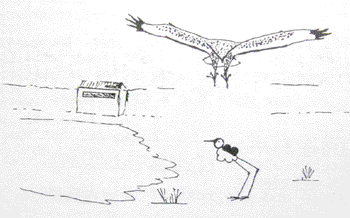
July 1987
The youngest stilt chick
About to die of natural causes
Reviews
The Spurnuda Triangle. By Eric Von Dunnocken. Suspense Publications, Hull, 137 pages, 2 colour plates, 17 line drawings, £16.95.
Eric Von Dunnocken is at it again. In this riveting work he describes a remote area in Yorkshire where rarities mysteriously disappear, without trace, only to reappear miraculously in hedgerows many miles away. Von Dunnocken believes the earth’s “lay-lines” run through the triangle, and wreak strange effects on all life that occurs there.
A recluse, who lives in a shack amongst the wild, windswept dunes, seems somehow involved. Von Dunnocken’s investigations have revealed that this man is often the last person near a rare bird before it vanishes, and that he leads ceremonies based on ancient pagan rites, including the casting of birds into the air in the dead of night, and the worship of an owl by a small, clannish sect.
Large Jock Raps the Shorebirds
You’ve done the Funky Chicken; now get down to the Sanderling Strut. An album guaranteed to make your body pop as the pulsing rhythms pound. This is pure music of the streets and sewage farms.
An innovative album, especially on the heavy funk track “Jack Snipe Your Body”. Even Large Jock’s powerful whistling appears muted by comparison to the raucous renderings of guest artists Goldie Plover and Tina Turnstone on the extended disco remix of “Gonna get up the tundra and find me a chick”, much criticised for its apparent support of paedophilia and banned by the BBC.
Prince should take note – the big people are a-coming up on the dance scene; maybe his bodyguard will produce an up-tempo version of his sound guide to the Empidonax flycatchers.
Guide to the Birders. By Hugh Town. Lister and Son, 1987, 227 pages, many colour illustrations – some reades may find these offensive.
These, days, birdwatching is not just a matter of watching birds. If you want to get ahead, be one of the boys, you need to know your birders. This essential new guide tell you how to identify all Britain’s top birders (why aren’t we in it? Eds.). Range maps and likely months of occurrence are included for each, together with details of distinctive mannerisms, deformities and feeding habits.
There are unfortuanate errors – the picture captioned “moulting Francis at Hartlepool” is in fact a 53rd summer Bland, as evidenced by the exposed tertials and odd-coloured feet. However, this book is worth buying for the photographs alone. You will never again be the only one not to recognise Jon Rohns at a major twitch.
Domesday Book. By John Goodegg. Caxton Press, 1066. 366 pages, many illuminated.
Subtitled “Where to Have Gone Birding”, this handy guide covers the major birding sites during the Middle Ages, when Red-backed Shrikes hunted Corncrakes on every village green. This updated version has been revised to take account of the dissolution of the monasteries and the recent practice of sheep-shearing, which have created interesting new habitats in the south of England. Especially noteworthy is the appearance of a bird called the Stone-Curlew, or Wailing Heath-Chicken, which has not previously been known to breed in this country.
Advertisement
Exotic Book Service from Bird Aids Ltd
Although most would strenuously deny it, many birders feel the perfectly natural urge from time to time to consult a field guide. However, even in these liberal minded times few birders are able to openly confess that they need a field guide; the social stigma is still tremendous.
Fortunately, we are able to supply a wide range of field guides, showing – in full colour and in a variety of poses – birds from many parts of the world. Guides are supplied complete with covers disguising them as car repair manuals, road maps or Reader’s Digest gardening guides.
Order with confidence. All books are despatched in a plain brown envelope within two working days. Your mum will just think it’s another load of Swedish pornographic magazines.
DUDING
Yes! Two of Britain’s best-loved dudes, Robert McDougall and Toney Ropey, have collaborated to bring you a brand-new magazine – Duding.
Join NOW and get a free copy of Frontiers of Misidentification.
Each month’s issue will bring you: The latest spottings from our correspondent in Wimbledon. DIM Witted’s Self-indulgence Spot – paintings of birds you will never see once in a million Sundays.
PLUS!: Green welly tests. What to put in the hamper. Should you leave your telescope at home in case it gets dirty? Is it safe to do it more than once a week? – our doctor advises. What to do if your life list gets bigger than 100.
I’d cancel my subscription for a start, Eds.
Katuschka Tours
New destinations, starting this year – Fiji, Nicaragua, Sri Lanka and South Korea.
8-day seawatch on the Persian Gulf Cruise – starting in Kuwait, the cruise in our recently re-registered boat finishes at the Straits of Hormuz. Anything could turn up! Who knows what you might see flying towards you or floating in the water.
China – 15-day spring tour. Youve seen films of places like Kenya, with its huge herds of Wildebeest and vaast flocks of Flamingos. Well we offer a contrast, this is nothing like Kenya. The tour takes you through vast track of country which once teemed with wildlife and where it is virtually impossible to find any birds. The first morning will be spent in Beijing, listening to the dawn chorus, only to find all the birds are caged.
Lebanon – 1-day autumn tour. For the adventurous with a touch of the gung-ho. We stay in the Peace and Love Hotel in strife-torn Beirut. From the rooftop, you will be able to dodge snipers’ bullets whilst joining the youth of the country in their second favourite past-time – blowing away most of Europe’s storks and eagles as they migrate overhead. Even more fun than Space Invaders. Previous tour members have been so captivated that they have spent the rest of their lives there.
Pacific Test Sites – 3-hour tour. See the shattered remains of beautiful, Pacific atolls. A novel feature of this trip is the chance to watch evolution in action, as animals (and maybe one or two tour members) mutate before your eyes. You’ll be glowing with satisfaction. Don’t forget to pack your Geiger counter!
Japanese Rainforest Bonanza – 5-month spring tour. Rainforests in Japan? Yes indeed. Or almost. The tour starts at a quayside, where we’ll see tons and tons of hardwood being unloaded. Then, we watch houses being built from the wood: they”ll soon fall down, but who cares? – no one wants an old one anyway.
Each night, we will eat at the finest restaurants in Kyoto, while our guest lecturer relates something of the wildlife which was killed in providing our disposable chopsticks. We hope to include a trip to see whales being landed, and may be lucky enough to witness a spot of dolphin bashing.
Katuschka Tours will make your knuckles whiter
 Wheat-O-Clear!
Wheat-O-Clear!
Do you suffer from dipper’s headache (dymsomania)? Now you need never worry again. Just take two soluble Black-eared Wheatears a day, and all your troutles will vanish.
New Wheat-O-Clear has been specially formulated for solubility. It’s true – just leave one overnight in a Hampshire rainstorm, and it has completely disappeared by morning.

 Wheat-O-Clear!
Wheat-O-Clear!
